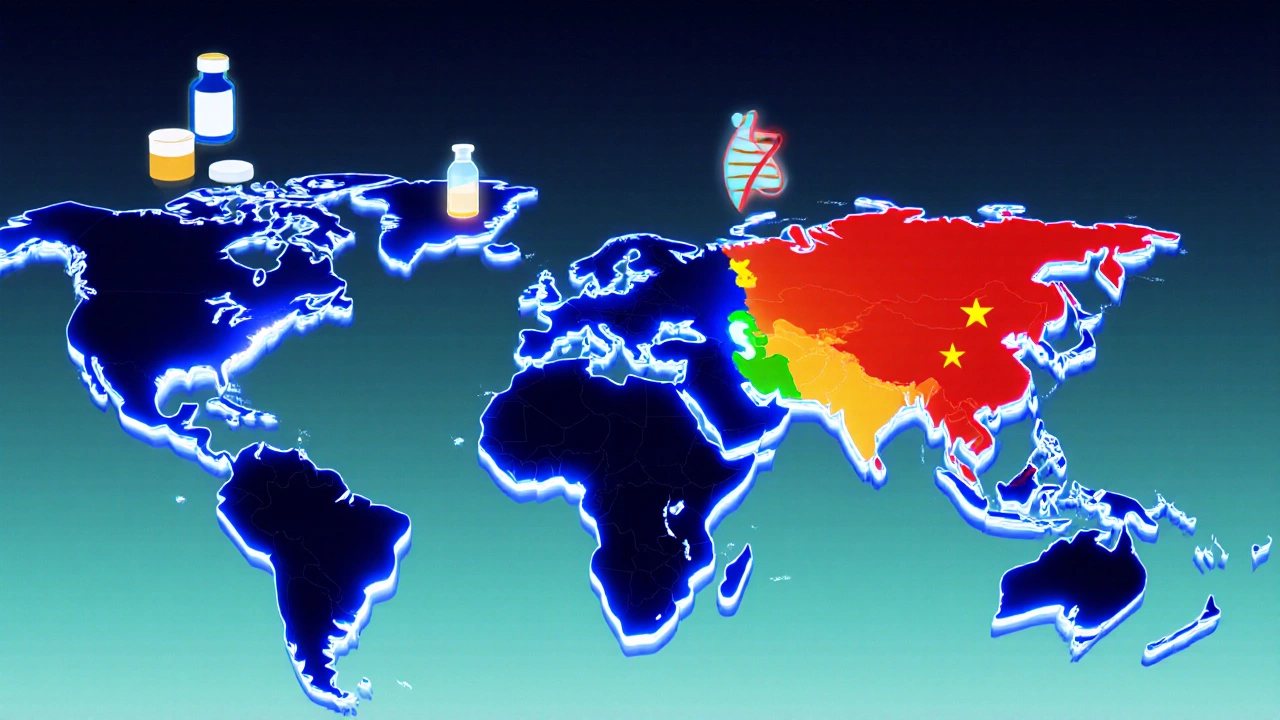
India’s Global Rank in the Pharmaceutical Industry - 2024 Overview
Discover India's 2024 rank in the global pharmaceutical industry, key drivers, major exporters, and what it takes to climb higher. A detailed, data‑rich guide.
When talking about Indian pharma exports, the flow of medicines, bulk drugs and finished formulations from India to overseas markets. Also known as India's pharmaceutical export sector, it fuels a big slice of the world’s drug supply. The engine behind this surge includes giants like Sun Pharma, the top‑exporting Indian pharma company and Cipla, a leader in generic drug shipments. Success hinges on meeting FDA regulations, U.S. safety standards for imported medicines and strict GMP compliance, good manufacturing practices required for export. These factors shape the credibility and reach of every shipment.
Indian pharma exports encompass a wide range of products – from bulk active pharmaceutical ingredients (APIs) to finished dosage forms like tablets, injectables and syrups. The sector’s breadth means it serves diverse markets: the United States demands high‑quality generic drugs, Europe looks for cost‑effective APIs, and emerging economies need affordable medicines for chronic diseases. Export growth requires FDA clearance, which in turn pushes manufacturers toward tighter quality controls, better documentation and more transparent supply chains. In practice, a company that clears the FDA can tap into the $40 billion U.S. market, while those lacking clearance stay confined to lower‑margin regions.
Three main forces drive the rise of Indian pharma exports today. First, cost competitiveness – Indian factories can produce APIs at 30‑40 % less than many Western peers, thanks to lower labor costs and mature supply networks. Second, regulatory alignment – over the past decade, Indian firms have aligned processes with US‑FDA and EU standards, earning certifications that open high‑value markets. Third, government support – policies like the Production‑Linked Incentive (PLI) scheme reward companies that boost export volume, and trade agreements reduce tariffs for Indian drugs in major markets. Together, these forces turn India into a reliable source for both bulk chemicals and finished medicines.
Another essential piece of the puzzle is logistics. Shipping a batch of insulin or a container of antibiotics involves cold‑chain management, customs paperwork, and coordination with freight forwarders familiar with pharma regulations. Companies that invest in robust supply‑chain technology can cut lead times by 15‑20 %, giving them an edge in time‑sensitive markets like hospitals. Moreover, digital traceability platforms now let buyers track each shipment from factory gate to the final pharmacy, reinforcing trust and reducing the risk of counterfeit infiltration.
While the big names dominate headlines, a thriving ecosystem of mid‑size manufacturers also contributes significantly. Firms specializing in niche therapeutic areas – such as oncology, cardiology or anti‑viral drugs – often partner with multinational partners for joint development and export. These collaborations not only expand product portfolios but also bring in advanced R&D capabilities, driving the overall quality of Indian exports upward.
Regulatory challenges remain a constant hurdle. Apart from FDA approval, exporters must navigate the European Medicines Agency (EMA) guidelines, the Gulf Cooperation Council (GCC) standards, and country‑specific requirements in Africa and Latin America. Each region may demand separate certificates of analysis, different labeling languages, and unique packing specifications. Companies that maintain a dedicated regulatory affairs team can handle these variations efficiently, turning potential roadblocks into competitive advantages.
Looking ahead, two trends will shape the next wave of Indian pharma exports. The rise of biosimilars – complex biologic drugs that are cheaper alternatives to branded biologics – offers a multi‑billion‑dollar opportunity as patents expire worldwide. India is already investing in biosimilar manufacturing capacity, and early movers could capture market share in the U.S. and EU. Second, the push toward sustainable manufacturing – greener solvents, reduced water usage and carbon‑neutral plants – is becoming a buying criterion for environmentally conscious buyers. Companies that adopt green practices now are likely to enjoy preferential treatment in future tender processes.
To sum up, Indian pharma exports are a dynamic mix of cost advantage, regulatory rigor, and strategic logistics. The sector’s strength lies in its ability to serve a global customer base while continuously upgrading quality and sustainability. Below you’ll find a curated collection of articles that dive deeper into the most pressing topics – from the latest rankings of top exporters like Sun Pharma, to step‑by‑step guides on navigating FDA compliance, and insights into cost structures for new pharmacy startups. Explore these resources to see how the pieces fit together and what you can do to tap into the booming export market.

Discover India's 2024 rank in the global pharmaceutical industry, key drivers, major exporters, and what it takes to climb higher. A detailed, data‑rich guide.